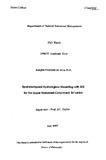JavaScript is disabled for your browser. Some features of this site may not work without it.
| dc.contributor.advisor | Taylor, J. C. | |
| dc.contributor.author | Premalal de Silva, Ranjith | |
| dc.date.accessioned | 2013-03-07T15:37:35Z | |
| dc.date.available | 2013-03-07T15:37:35Z | |
| dc.date.issued | 1997-07 | |
| dc.identifier.uri | http://dspace.lib.cranfield.ac.uk/handle/1826/7841 | |
| dc.description.abstract | Sustainability of water resources is imperative for the continued prosperity of Sri Lanka where the economy is dependent upon agriculture. The Mahaweli river is the longest in Sri Lanka, with the upper catchment covering an area of 3124 sq .km .. The Mahaweli Development programme, a major undertaking in the upper catchment has been implemented with the aims of providing Mahaweli water to the dry zone of the country through a massive diversion scheme and also for generating hydropower. Under this programme, seven large reservoirs have been constructed across the river and large scale land use changes in the catchment have occurred during the last two decades. Critics now say that the hydrological regime has been adversely affected due to indiscriminate land use changes and, as a result, river flows have diminished during the last two decades, thus jeopardising the expectations of this massive development programme. Reforestation programmes have been recommended because of the benefits of forest in resource conservation and also the water derived from fog interception. Selection of the best sites for these forest plantations for maximum benefits, especially in terms of water yield from fog interception has the utmost importance. This created the need for a comprehensive model to represent the hydrology and to simulate the hydrological dynamics of the catchment In conceptual terms, GIS is well suited for modelling with large and complex databases associated with hydrological parameters. However, hydrological modelling efforts in GIS are constrained by the limitations in the representation of time in its spatial data ,structures. The SPANS GIS software used in this study provided the capability of linking spatially distributed numerical parameters with corresponding tabulated data through mathematical and statistical expressions while implicitly representing temporality through iterative procedures.The spatial distribution of land use was identified through the supervised classification of IRS-IA LISS II imagery. Daily rainfall data for a 30 year period and corresponding gauging locations derived from GPS were managed and retrieved through a Lotus 1-2- 3 database. The fog interception component was estimated based on elevation and the monsoon season. Hydrological processes such as interception and evapotranspiration were derived from individual sub models and finally combined within the overall hydrological model structure. The model was run with daily time steps on numerical 'values of each quad cell of the thematic coverage. The information on flow derived from the model was depicted as a series of thematic maps in addition to the time series of numerical values at subcatchment and catchment outlets. The results confirmed that the model is capable of simulating catchment response of the UMCA successfully. The time dimension was accommodated through a senes of non-interactive REXX programmes in developing the customised version of the model. It is concluded that the software architecture of SPANS GIS is capable of accommodating spatiotemporal modelling implicitly in its spatial data structures although changes in the model structure may necessitate considerable reprogramming. Sensitivity of the model for different spatial interpolation techniques was evaluated. Further, sensitivity of the model for the defined hydrological parameters, spatial 'resolution and land use was also assessed. The model is sensitive to land use changes in the catchment and it shows 15-35% annual increase of runoff when forests are converted to grassland. Further studies are required to develop a more detailed set of hydrological parameters for the model. | en_UK |
| dc.language.iso | en | en_UK |
| dc.publisher | Cranfield University | en_UK |
| dc.title | Spatiotemporal Hydrological Modelling with GIS for the Upper Mahaweli Catchment, Sri Lanka | en_UK |
| dc.type | Thesis or dissertation | en_UK |
| dc.type.qualificationlevel | Doctoral | en_UK |
| dc.type.qualificationname | PhD | en_UK |
